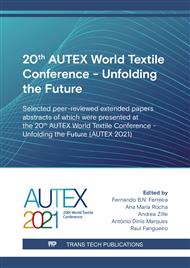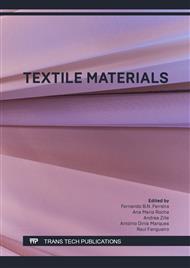[1]
Dorigato, A., V. Moretti, S. Dul, S.H. Unterberger, A. Pegoretti, Electrically conductive nanocomposites for fused deposition modelling, Synth. Met. 2017, 226, 7–14.
DOI: 10.1016/j.synthmet.2017.01.009
Google Scholar
[2]
Marischal, L., A. Cayla, G. Lemort, C. Campagne, D. Éric, Selection of immiscible polymer blends filled with carbon nanotubes for heating applications, Polymers (Basel). 2019, 11, 1–16.
DOI: 10.3390/polym11111827
Google Scholar
[3]
G, T., M. N, K. T, Development and Characterization of Electric Heating Fabric Based on Silver Coated Nylon Yarn, J. Text. Eng. Fash. Technol. 2017, 1, 1–3.
Google Scholar
[4]
Asghar, A., M.R. Ahmad, M.F. Yahya, Effects of metal filament's alignment on tensile and electrical properties of conductive hybrid cover yarns, Fash. Text. 2016, 3, 3.
DOI: 10.1186/s40691-015-0055-4
Google Scholar
[5]
Zhang, L., M. Baima, T.L. Andrew, Transforming commercial textiles and threads into sewable and weavable electric heaters, ACS Appl. Mater. Interfaces. 2017, 9, 32299–32307.
DOI: 10.1021/acsami.7b10514
Google Scholar
[6]
E. Cronn, C., Textile based heating apparatus and method, US 2008/0223844 A1, (2008).
Google Scholar
[7]
Feller, J.F., I. Linossier, Y. Grohens, Conductive polymer composites: Comparative study of poly(ester)-short carbon fibres and poly(epoxy)-short carbon fibres mechanical and electrical properties, Mater. Lett. 2002, 57, 64–71.
DOI: 10.1016/s0167-577x(02)00700-0
Google Scholar
[8]
Dorigato, A., M. Brugnara, A. Pegoretti, Synergistic effects of carbon black and carbon nanotubes on the electrical resistivity of poly(butylene-terephthalate) nanocomposites, Adv. Polym. Technol. 2017, 1–11.
DOI: 10.1002/adv.21833
Google Scholar
[9]
Shijian Luo, C.P. Wong, Conductive polymer composites with positive temperature coefficient, in: Proc. Int. Symp. Adv. Packag. Mater. Process. Prop. Interfaces (IEEE Cat. No.99TH8405), IMAPS - Int. Microelectron. & Packaging Soc, 1999: p.311–316.
DOI: 10.1109/isapm.1999.757331
Google Scholar
[10]
Park, S.J., H.C. Kim, H.Y. Kim, Roles of work of adhesion between carbon blacks and thermoplastic polymers on electrical properties of composites, J. Colloid Interface Sci. 2002, 255, 145–149.
DOI: 10.1006/jcis.2002.8481
Google Scholar
[11]
Bauhofer, W., J.Z. Kovacs, A review and analysis of electrical percolation in carbon nanotube polymer composites, Compos. Sci. Technol. 2009, 69, 1486–1498.
DOI: 10.1016/j.compscitech.2008.06.018
Google Scholar
[12]
Mamunya, Y.P., V. V. Davydenko, P. Pissis, E. V. Lebedev, Electrical and thermal conductivity of polymers filled with metal powders, Eur. Polym. J. 2002, 38, 1887–1897.
DOI: 10.1016/s0014-3057(02)00064-2
Google Scholar
[13]
Zhang, Q., H. Jin, X. Wang, X. Jing, Morphology of conductive blend fibers of polyaniline and polyamide-11, Synth. Met. 2001, 123, 481–485.
DOI: 10.1016/s0379-6779(01)00354-x
Google Scholar
[14]
Ounaies, Z., C. Park, K.E. Wise, E.J. Siochi, J.S. Harrison, Electrical properties of single wall carbon nanotube reinforced polyimide composites, Compos. Sci. Technol. 2003, 63, 1637–1646.
DOI: 10.1016/s0266-3538(03)00067-8
Google Scholar
[15]
Szeluga, U., B. Kumanek, B. Trzebicka, Synergy in hybrid polymer/nanocarbon composites. A review, Compos. Part A Appl. Sci. Manuf. 2015, 73, 204–231.
DOI: 10.1016/j.compositesa.2015.02.021
Google Scholar
[16]
Kozlowski, M., A. Kozlowska, Comparison of electrically conductive fillers in polymer systems, Macromol. Symp. 1996, 108, 261–268.
DOI: 10.1002/masy.19961080121
Google Scholar
[17]
Xu, H., M. Qu, D.W. Schubert, Conductivity of poly(methyl methacrylate) composite films filled with ultra-high aspect ratio carbon fibers, Compos. Sci. Technol. 2019, 181,.
DOI: 10.1016/j.compscitech.2019.107690
Google Scholar
[18]
Mamunya, Y., L. Matzui, L. Vovchenko, O. Maruzhenko, V. Oliynyk, S. Pusz, B. Kumanek, U. Szeluga, Influence of conductive nano- and microfiller distribution on electrical conductivity and EMI shielding properties of polymer/carbon composites, Compos. Sci. Technol. 2019, 170, 51–59.
DOI: 10.1016/j.compscitech.2018.11.037
Google Scholar
[19]
Villmow, T., P. Pötschke, S. Pegel, L. Häussler, B. Kretzschmar, Influence of twin-screw extrusion conditions on the dispersion of multi-walled carbon nanotubes in a poly(lactic acid) matrix, Polymer (Guildf). 2008, 49, 3500–3509.
DOI: 10.1016/j.polymer.2008.06.010
Google Scholar
[20]
Feller, J.F., É. Petitjean, Conductive polymer composites(CPC): influence of processing conditions, shear rate and temperature on electrical properties of poly(butylene terephthalate) / poly(amide12-b-tetramethyleneglycol)– carbon black blends, Macromol. Symp. 2003, 203, 309–316.
DOI: 10.1002/masy.200351334
Google Scholar
[21]
Király, A., F. Ronkay, Effect of graphite and carbon black fillers on the processability, electrical conductivity and mechanical properties of polypropylenebased bipolar plates, Polym. Polym. Compos. 2013, 21, 93–100.
DOI: 10.1177/096739111302100206
Google Scholar
[22]
Bhat, N. V., D.T. Seshadri, M.M. Nate, A. V. Gore, Development of conductive cotton fabrics for heating devices, J. Appl. Polym. Sci. 2006, 102, 4690–4695.
DOI: 10.1002/app.24708
Google Scholar
[23]
Droval, G., P. Glouannec, J.F. Feller, P. Salagnac, Simulation of electrical and thermal behavior of conductive polymer composites heating elements, J. Thermophys. Heat Transf. 2005, 19, 375–381.
DOI: 10.2514/1.12718
Google Scholar
[24]
Feller, J.-F., Conductive polymer composites: Influence of extrusion conditions on positive temperature coefficient effect of poly (butylene terephthalate)/poly (olefin)–carbon black, J. Appl. Polym. Sci. 2004, 91, 2151–2157.
DOI: 10.1002/app.13337
Google Scholar
[25]
Nakano, H., K. Shimizu, S. Takahashi, A. Kono, T. Ougizawa, H. Horibe, Resistivity-temperature characteristics of filler-dispersed polymer composites, Polym. (United Kingdom). 2012, 53, 6112–6117.
DOI: 10.1016/j.polymer.2012.10.046
Google Scholar
[26]
Li, Q., Siddaramaiah, N.H. Kim, G.H. Yoo, J.H. Lee, Positive temperature coefficient characteristic and structure of graphite nanofibers reinforced high density polyethylene/carbon black nanocomposites, Compos. Part B Eng. 2009, 40, 218–224.
DOI: 10.1016/j.compositesb.2008.11.002
Google Scholar
[27]
Xinfang, C., J. Wentao, T. Hao, Y. Huali, Effect of Irradiation on PTC Performances of Carbon Black Filled Polymer Composites, n.d., 408–413.
Google Scholar
[28]
Zhao, Z., W. Yu, X. He, X. Chen, The conduction mechanism of carbon black-filled poly(vinylidene fluoride) composite, Mater. Lett. 2003, 57, 3082–3088.
DOI: 10.1016/s0167-577x(02)01440-4
Google Scholar
[29]
Chatterjee, K., J. Tabor, T.K. Ghosh, Electrically Conductive Coatings for Fiber-Based E- Textiles, 2019,.
Google Scholar
[30]
Shim, B.S., W. Chen, C. Doty, C. Xu, N.A. Kotov, Smart electronic yarns and wearable fabrics for human biomonitoring made by carbon nanotube coating with polyelectrolytes, Nano Lett. 2008, 8, 4151–4157.
DOI: 10.1021/nl801495p
Google Scholar
[31]
Ye, H., K. Wang, J. Zhou, L. Song, L. Gu, X. Cao, A true cable assembly with a carbon nanotube sheath and nickel wire core: a fully flexible electrode integrating energy storage and electrical conduction, J. Mater. Chem. A. 2018, 6, 1109–1118.
DOI: 10.1039/c7ta08758f
Google Scholar
[32]
Shimizu, Y., T. Sasaki, C. Liang, A.C. Bose, T. Ito, K. Terashima, N. Koshizaki, Cylindrical metal wire surface coating with multiwalled carbon nanotubes by an atmospheric-pressure microplasma CVD technique, Chem. Vap. Depos. 2005, 11, 244–249.
DOI: 10.1002/cvde.200406349
Google Scholar
[33]
Marischal, L., A. Cayla, G. Lemort, C. Campagne, É. Devaux, Influence of melt spinning parameters on electrical conductivity of carbon fillers filled polyamide 12 composites, Synth. Met. 2018, 245, 51–60.
DOI: 10.1016/j.synthmet.2018.08.003
Google Scholar
[34]
Fournier, J., G. Boiteux, G. Seytre, G. Marichy, Positive temperature coefficient effect in carbon black/epoxy polymer composites, J. Mater. Sci. …. 1997, 6, 1677–1679.
DOI: 10.1023/a:1018582216002
Google Scholar



